Abstract
Cholesteryl ester transfer protein (CETP) promotes in vitro transfer of cholesteryl ester (CE) and triglyceride (TG) between lipoproteins. We studied the function of CETP in vivo in rabbit lipoprotein metabolism using a neutralizing monoclonal antibody (MAb, TP1) to CETP. Rabbits were injected with TP1 (n = 8), or irrelevant MAb or saline (control, n = 8), resulting in an initial 71% inhibition of CETP, which fell to 45% after 48 h. HDL CE rose in the inhibited animals, reaching levels that doubled initial and control values at 48 h (P less than 0.001). HDL TG fell reciprocally, but HDL protein did not change, suggesting a CE for TG exchange. VLDL CE/TG decreased. Rabbits were also given [3H]cholesteryl ether HDL (a CE analogue). CETP inhibition delayed the initial clearance of radioactivity from HDL (control 6.8 vs. TP1 4.1 pools/d) and plasma (7.8 vs. 5.2 pools/d). We conclude that CETP plays a quantitatively important role in HDL CE catabolism in the rabbit, promoting the exchange of TG for CE and the clearance of CE from plasma.
Full text
PDF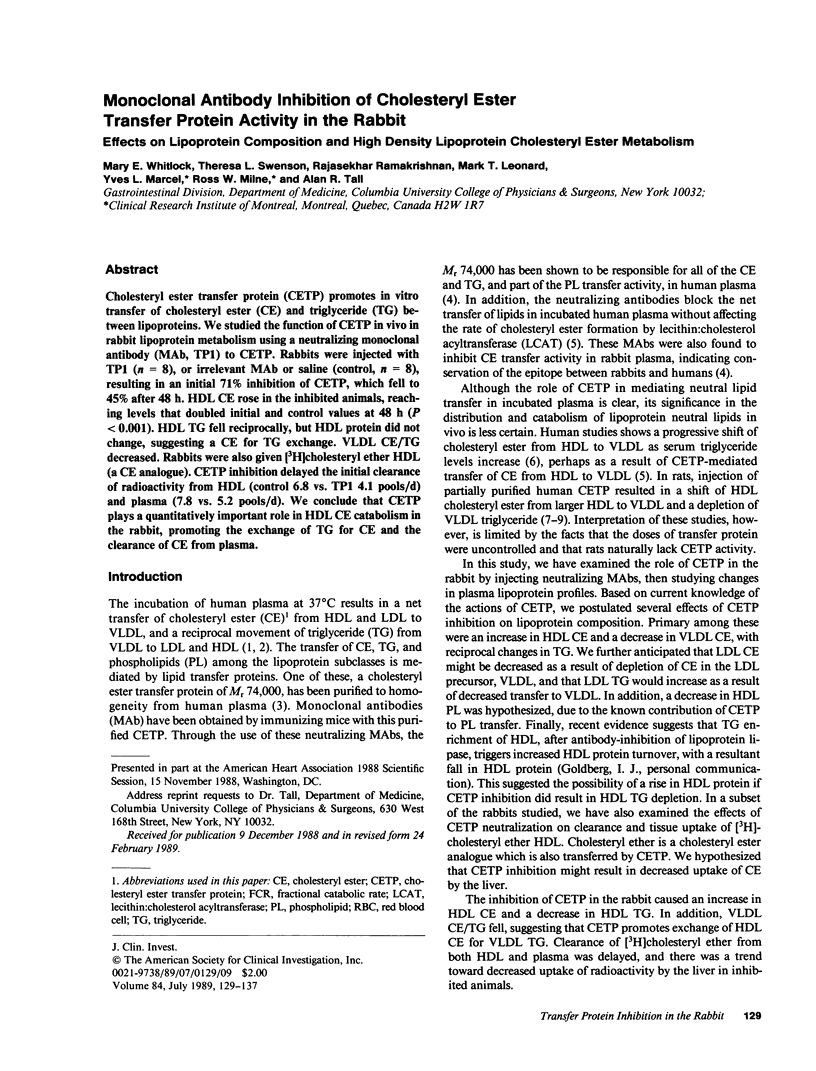
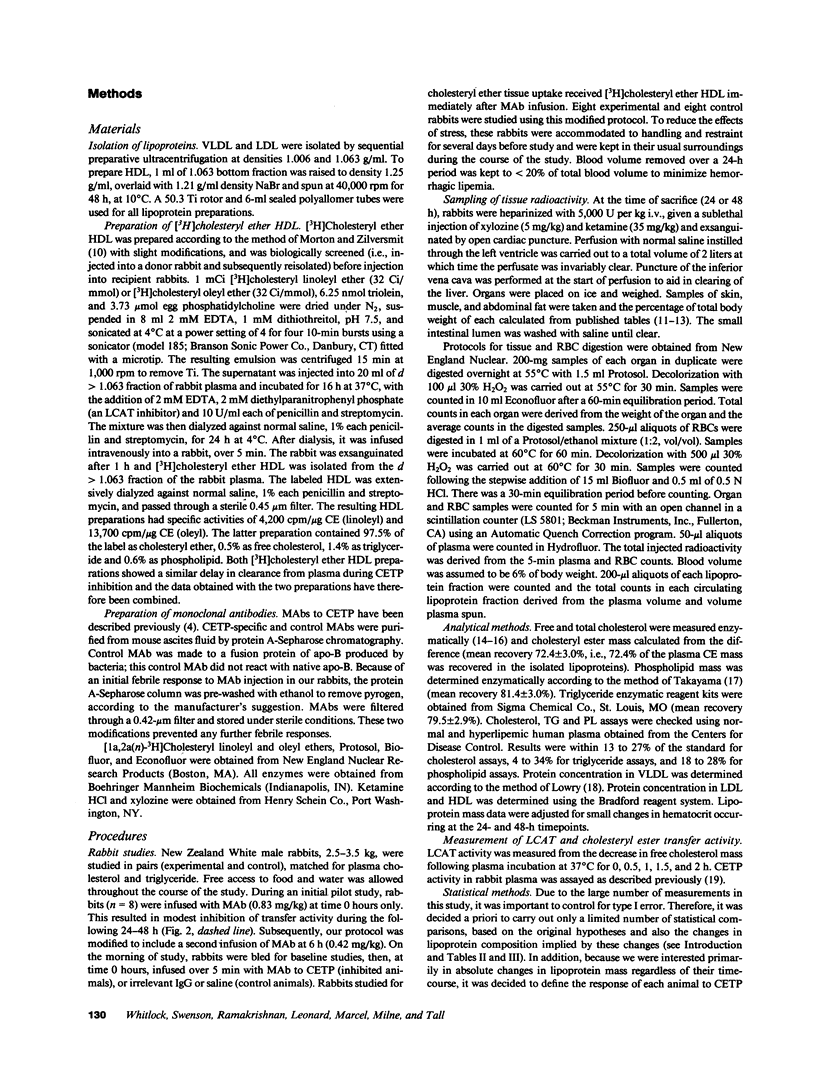
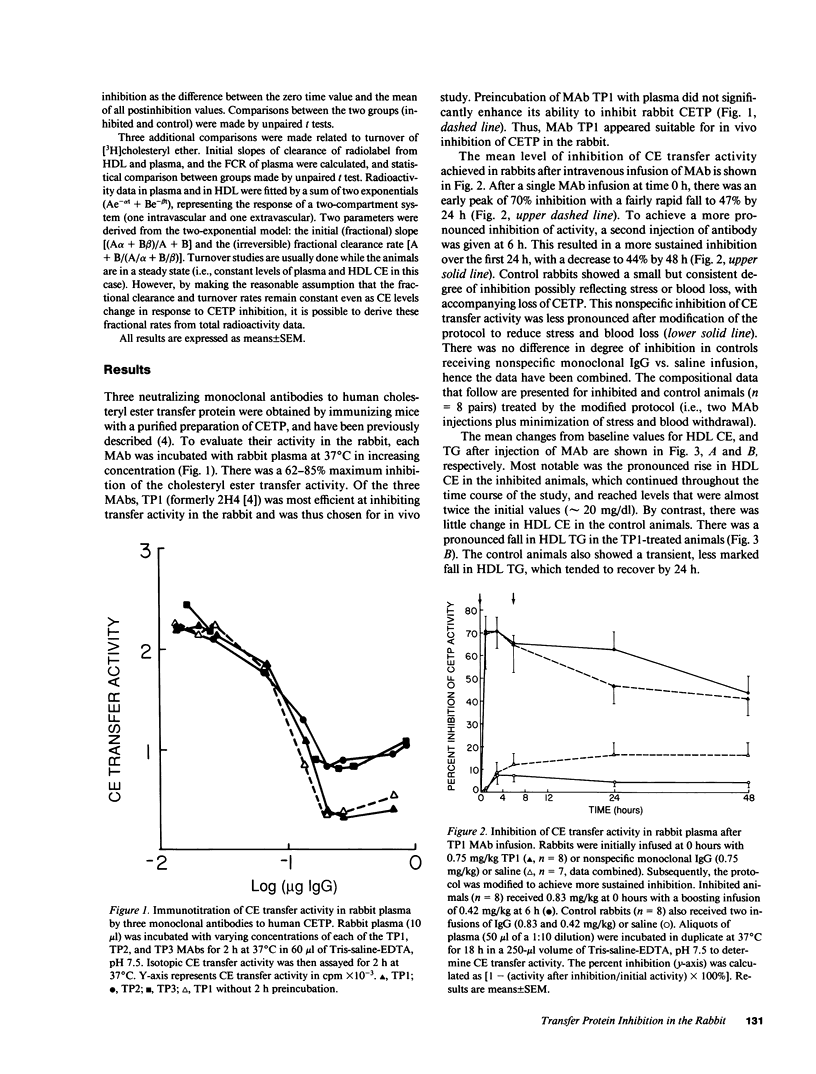

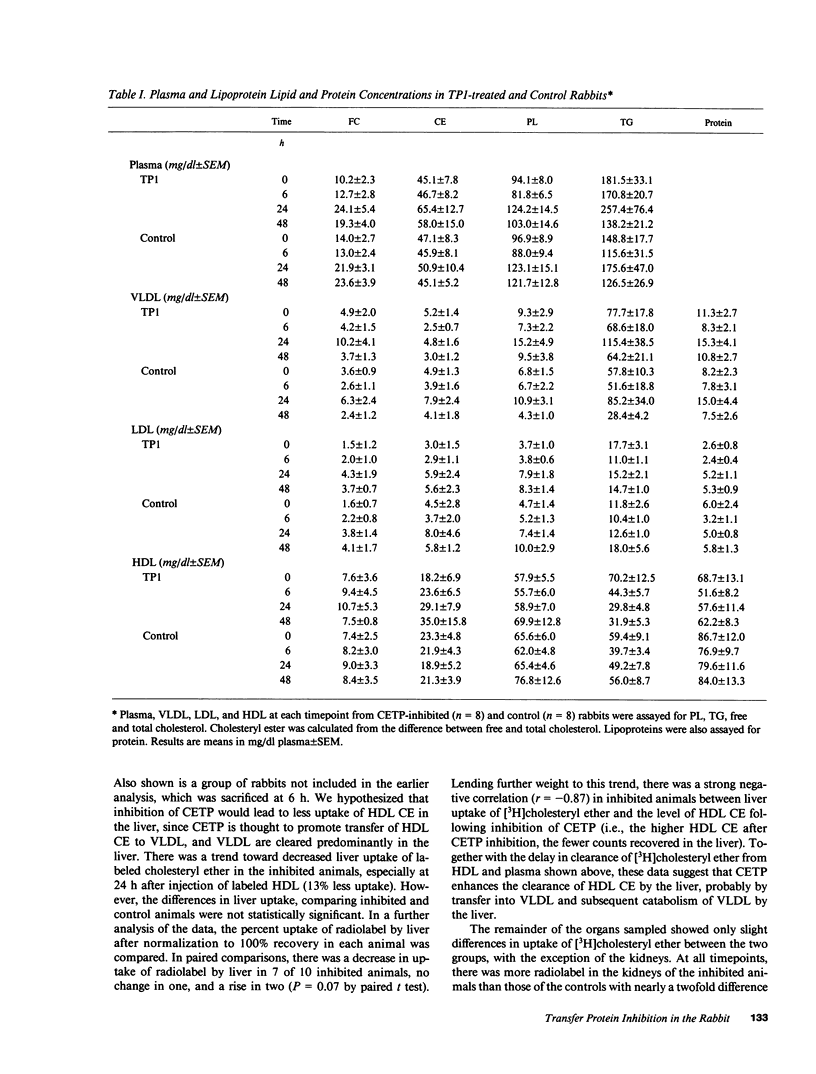
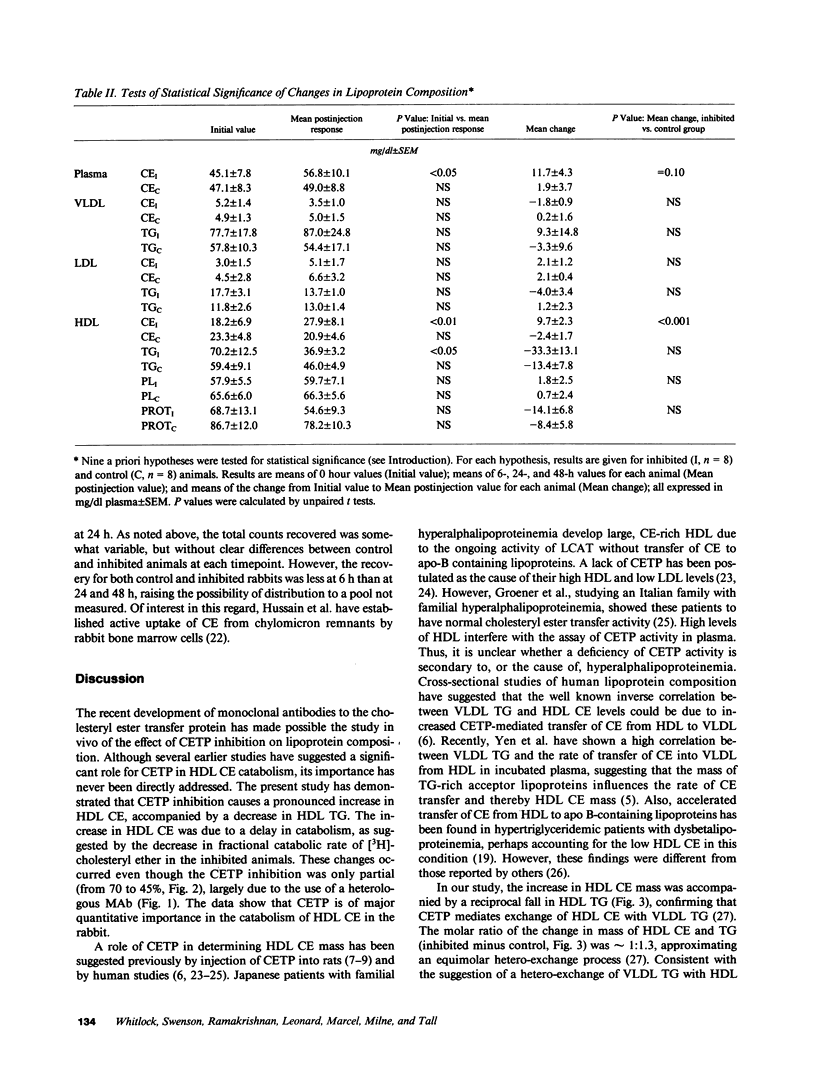
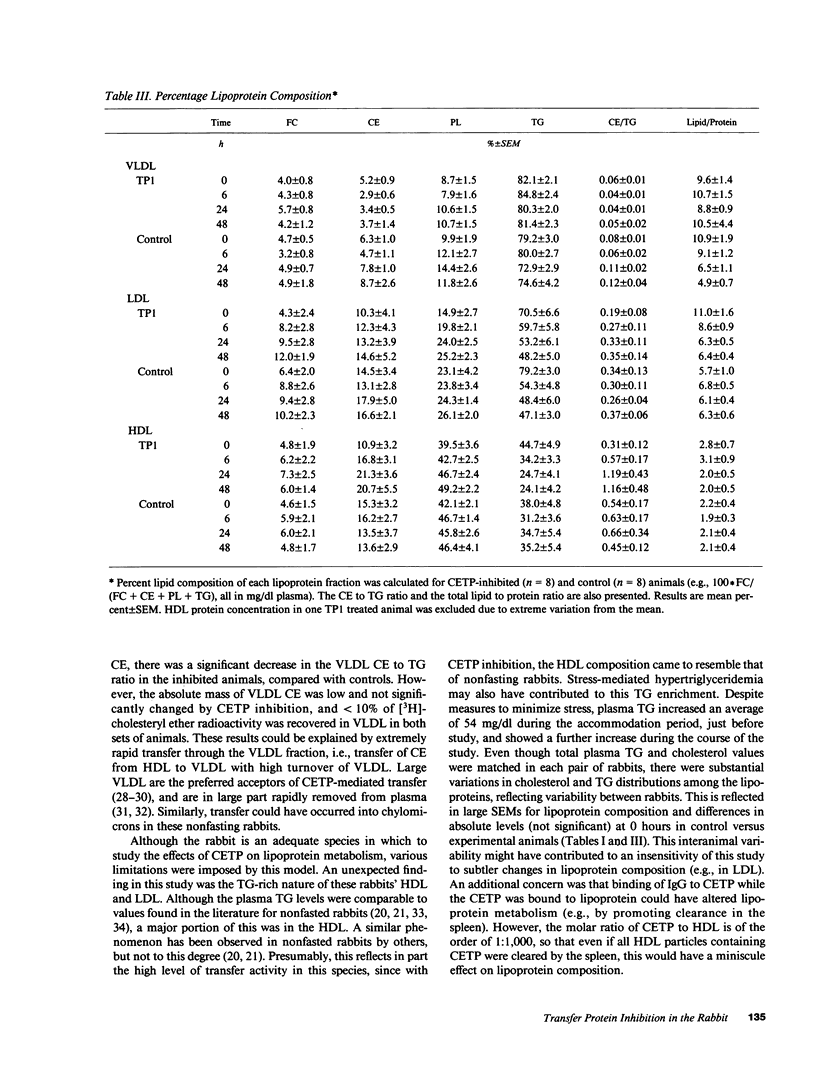
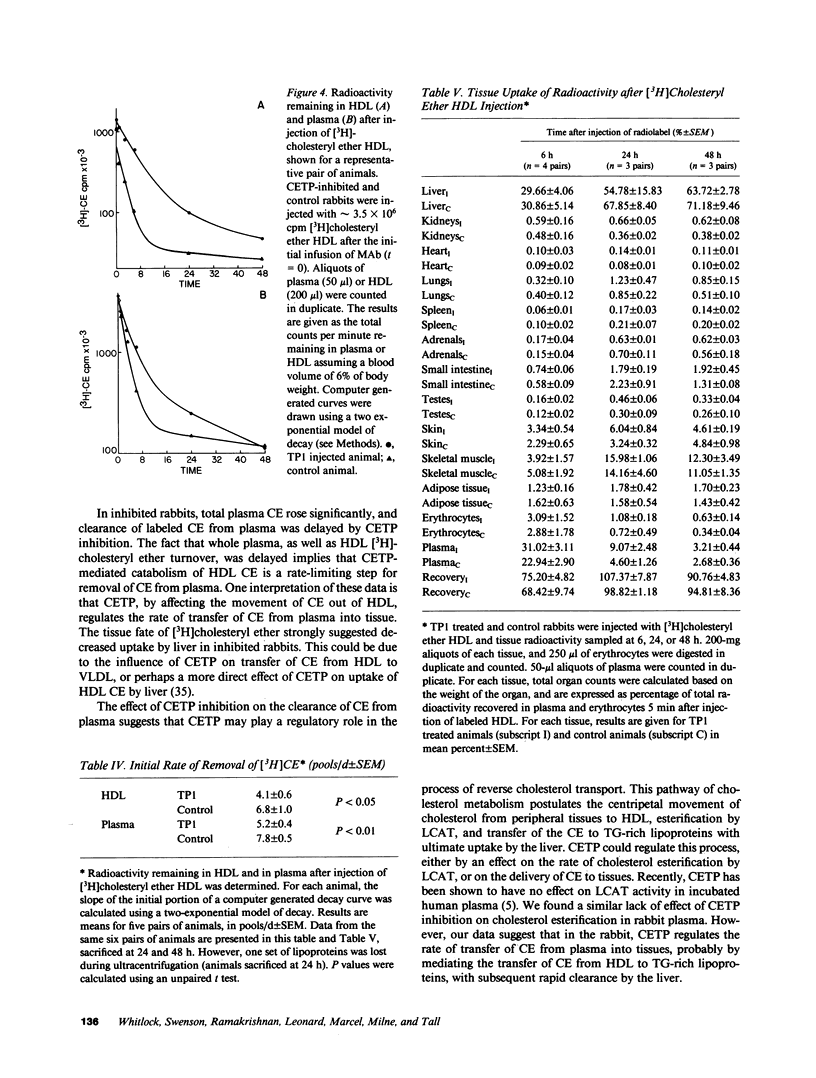
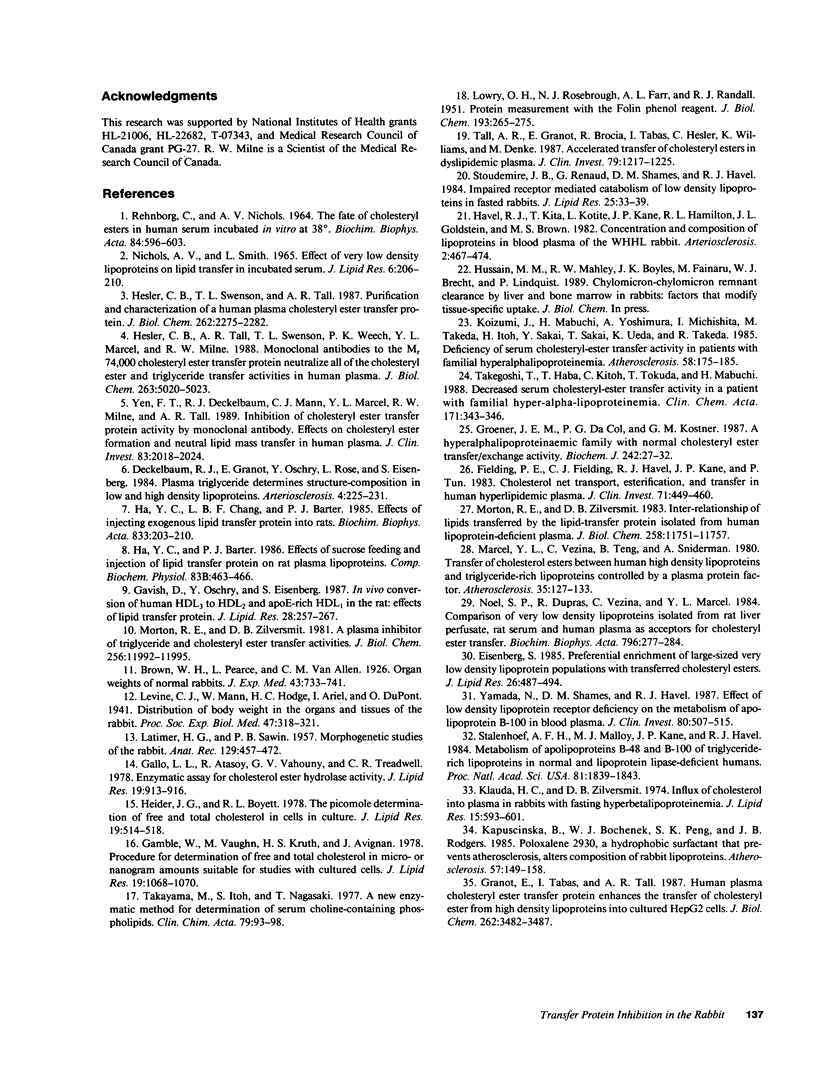
Selected References
These references are in PubMed. This may not be the complete list of references from this article.
- Deckelbaum R. J., Granot E., Oschry Y., Rose L., Eisenberg S. Plasma triglyceride determines structure-composition in low and high density lipoproteins. Arteriosclerosis. 1984 May-Jun;4(3):225–231. doi: 10.1161/01.atv.4.3.225. [DOI] [PubMed] [Google Scholar]
- Eisenberg S. Preferential enrichment of large-sized very low density lipoprotein populations with transferred cholesteryl esters. J Lipid Res. 1985 Apr;26(4):487–494. [PubMed] [Google Scholar]
- Fielding P. E., Fielding C. J., Havel R. J., Kane J. P., Tun P. Cholesterol net transport, esterification, and transfer in human hyperlipidemic plasma. J Clin Invest. 1983 Mar;71(3):449–460. doi: 10.1172/JCI110789. [DOI] [PMC free article] [PubMed] [Google Scholar]
- Gallo L. L., Atasoy R., Vahouny G. V., Treadwell C. R. Enzymatic assay for cholesterol ester hydrolase activity. J Lipid Res. 1978 Sep;19(7):913–916. [PubMed] [Google Scholar]
- Gamble W., Vaughan M., Kruth H. S., Avigan J. Procedure for determination of free and total cholesterol in micro- or nanogram amounts suitable for studies with cultured cells. J Lipid Res. 1978 Nov;19(8):1068–1070. [PubMed] [Google Scholar]
- Gavish D., Oschry Y., Eisenberg S. In vivo conversion of human HDL3 to HDL2 and apoE-rich HDL1 in the rat: effects of lipid transfer protein. J Lipid Res. 1987 Mar;28(3):257–267. [PubMed] [Google Scholar]
- Granot E., Tabas I., Tall A. R. Human plasma cholesteryl ester transfer protein enhances the transfer of cholesteryl ester from high density lipoproteins into cultured HepG2 cells. J Biol Chem. 1987 Mar 15;262(8):3482–3487. [PubMed] [Google Scholar]
- Ha Y. C., Barter P. J. Effects of sucrose feeding and injection of lipid transfer protein on rat plasma lipoproteins. Comp Biochem Physiol B. 1986;83(2):463–466. doi: 10.1016/0305-0491(86)90396-2. [DOI] [PubMed] [Google Scholar]
- Ha Y. C., Chang L. B., Barter P. J. Effects of injecting exogenous lipid transfer protein into rats. Biochim Biophys Acta. 1985 Feb 8;833(2):203–210. doi: 10.1016/0005-2760(85)90191-2. [DOI] [PubMed] [Google Scholar]
- Havel R. J., Kita T., Kotite L., Kane J. P., Hamilton R. L., Goldstein J. L., Brown M. S. Concentration and composition of lipoproteins in blood plasma of the WHHL rabbit. An animal model of human familial hypercholesterolemia. Arteriosclerosis. 1982 Nov-Dec;2(6):467–474. doi: 10.1161/01.atv.2.6.467. [DOI] [PubMed] [Google Scholar]
- Heider J. G., Boyett R. L. The picomole determination of free and total cholesterol in cells in culture. J Lipid Res. 1978 May;19(4):514–518. [PubMed] [Google Scholar]
- Hesler C. B., Swenson T. L., Tall A. R. Purification and characterization of a human plasma cholesteryl ester transfer protein. J Biol Chem. 1987 Feb 15;262(5):2275–2282. [PubMed] [Google Scholar]
- Hesler C. B., Tall A. R., Swenson T. L., Weech P. K., Marcel Y. L., Milne R. W. Monoclonal antibodies to the Mr 74,000 cholesteryl ester transfer protein neutralize all of the cholesteryl ester and triglyceride transfer activities in human plasma. J Biol Chem. 1988 Apr 15;263(11):5020–5023. [PubMed] [Google Scholar]
- Kapuscinska B., Bochenek W. J., Peng S. K., Rodgers J. B. Poloxalene 2930, a hydrophobic surfactant that prevents atherosclerosis, alters composition of rabbit lipoproteins. Atherosclerosis. 1985 Nov;57(2-3):149–158. doi: 10.1016/0021-9150(85)90028-0. [DOI] [PubMed] [Google Scholar]
- Klauda H. C., Zilversmit D. B. Influx of cholesterol into plasma in rabbits with fasting hyperbetalipoproteinemia. J Lipid Res. 1974 Nov;15(6):593–601. [PubMed] [Google Scholar]
- Koizumi J., Mabuchi H., Yoshimura A., Michishita I., Takeda M., Itoh H., Sakai Y., Sakai T., Ueda K., Takeda R. Deficiency of serum cholesteryl-ester transfer activity in patients with familial hyperalphalipoproteinaemia. Atherosclerosis. 1985 Dec;58(1-3):175–186. doi: 10.1016/0021-9150(85)90064-4. [DOI] [PubMed] [Google Scholar]
- LATIMER H. B., SAWIN P. B. Morphogenetic studies of the rabbit. XIX. Organ size in relation to body size in large race III and in small race X. Anat Rec. 1957 Dec;129(4):457–472. doi: 10.1002/ar.1091290408. [DOI] [PubMed] [Google Scholar]
- LOWRY O. H., ROSEBROUGH N. J., FARR A. L., RANDALL R. J. Protein measurement with the Folin phenol reagent. J Biol Chem. 1951 Nov;193(1):265–275. [PubMed] [Google Scholar]
- Marcel Y. L., Vezina C., Teng B., Sniderman A. Transfer of cholesterol esters between human high density lipoproteins and triglyceride-rich lipoproteins controlled by a plasma protein factor. Atherosclerosis. 1980 Feb;35(2):127–133. doi: 10.1016/0021-9150(80)90078-7. [DOI] [PubMed] [Google Scholar]
- Morton R. E., Zilversmit D. B. A plasma inhibitor of triglyceride and cholesteryl ester transfer activities. J Biol Chem. 1981 Dec 10;256(23):11992–11995. [PubMed] [Google Scholar]
- Morton R. E., Zilversmit D. B. Inter-relationship of lipids transferred by the lipid-transfer protein isolated from human lipoprotein-deficient plasma. J Biol Chem. 1983 Oct 10;258(19):11751–11757. [PubMed] [Google Scholar]
- NICHOLS A. V., SMITH L. EFFECT OF VERY LOW-DENSITY LIPOPROTEINS ON LIPID TRANSFER IN INCUBATED SERUM. J Lipid Res. 1965 Apr;6:206–210. [PubMed] [Google Scholar]
- Noël S. P., Dupras R., Vézina C., Marcel Y. L. Comparison of very-low-density lipoproteins isolated from rat liver perfusate, rat serum and human plasma as acceptors for cholesteryl ester transfer. Biochim Biophys Acta. 1984 Dec 6;796(3):277–284. doi: 10.1016/0005-2760(84)90128-0. [DOI] [PubMed] [Google Scholar]
- REHNBORG C. S., NICHOLS A. V. THE FATE OF CHOLESTERYL ESTERS IN HUMAN SERUM INCUBATED IN VITRO AT 38 DEGREES. Biochim Biophys Acta. 1964 Oct 2;84:596–603. doi: 10.1016/0926-6542(64)90129-5. [DOI] [PubMed] [Google Scholar]
- Stalenhoef A. F., Malloy M. J., Kane J. P., Havel R. J. Metabolism of apolipoproteins B-48 and B-100 of triglyceride-rich lipoproteins in normal and lipoprotein lipase-deficient humans. Proc Natl Acad Sci U S A. 1984 Mar;81(6):1839–1843. doi: 10.1073/pnas.81.6.1839. [DOI] [PMC free article] [PubMed] [Google Scholar]
- Stoudemire J. B., Renaud G., Shames D. M., Havel R. J. Impaired receptor-mediated catabolism of low density lipoproteins in fasted rabbits. J Lipid Res. 1984 Jan;25(1):33–39. [PubMed] [Google Scholar]
- Takayama M., Itoh S., Nagasaki T., Tanimizu I. A new enzymatic method for determination of serum choline-containing phospholipids. Clin Chim Acta. 1977 Aug 15;79(1):93–98. doi: 10.1016/0009-8981(77)90465-x. [DOI] [PubMed] [Google Scholar]
- Takegoshi T., Haba T., Kitoh C., Tokuda T., Mabuchi H. Decreased serum cholesteryl-ester transfer activity in a patient with familial hyper-alpha-lipoproteinemia. Clin Chim Acta. 1988 Feb 15;171(2-3):343–345. doi: 10.1016/0009-8981(88)90163-5. [DOI] [PubMed] [Google Scholar]
- Tall A., Granot E., Brocia R., Tabas I., Hesler C., Williams K., Denke M. Accelerated transfer of cholesteryl esters in dyslipidemic plasma. Role of cholesteryl ester transfer protein. J Clin Invest. 1987 Apr;79(4):1217–1225. doi: 10.1172/JCI112940. [DOI] [PMC free article] [PubMed] [Google Scholar]
- Yamada N., Shames D. M., Havel R. J. Effect of low density lipoprotein receptor deficiency on the metabolism of apolipoprotein B-100 in blood plasma. Kinetic studies in normal and Watanabe heritable hyperlipidemic rabbits. J Clin Invest. 1987 Aug;80(2):507–515. doi: 10.1172/JCI113099. [DOI] [PMC free article] [PubMed] [Google Scholar]
- Yen F. T., Deckelbaum R. J., Mann C. J., Marcel Y. L., Milne R. W., Tall A. R. Inhibition of cholesteryl ester transfer protein activity by monoclonal antibody. Effects on cholesteryl ester formation and neutral lipid mass transfer in human plasma. J Clin Invest. 1989 Jun;83(6):2018–2024. doi: 10.1172/JCI114112. [DOI] [PMC free article] [PubMed] [Google Scholar]


